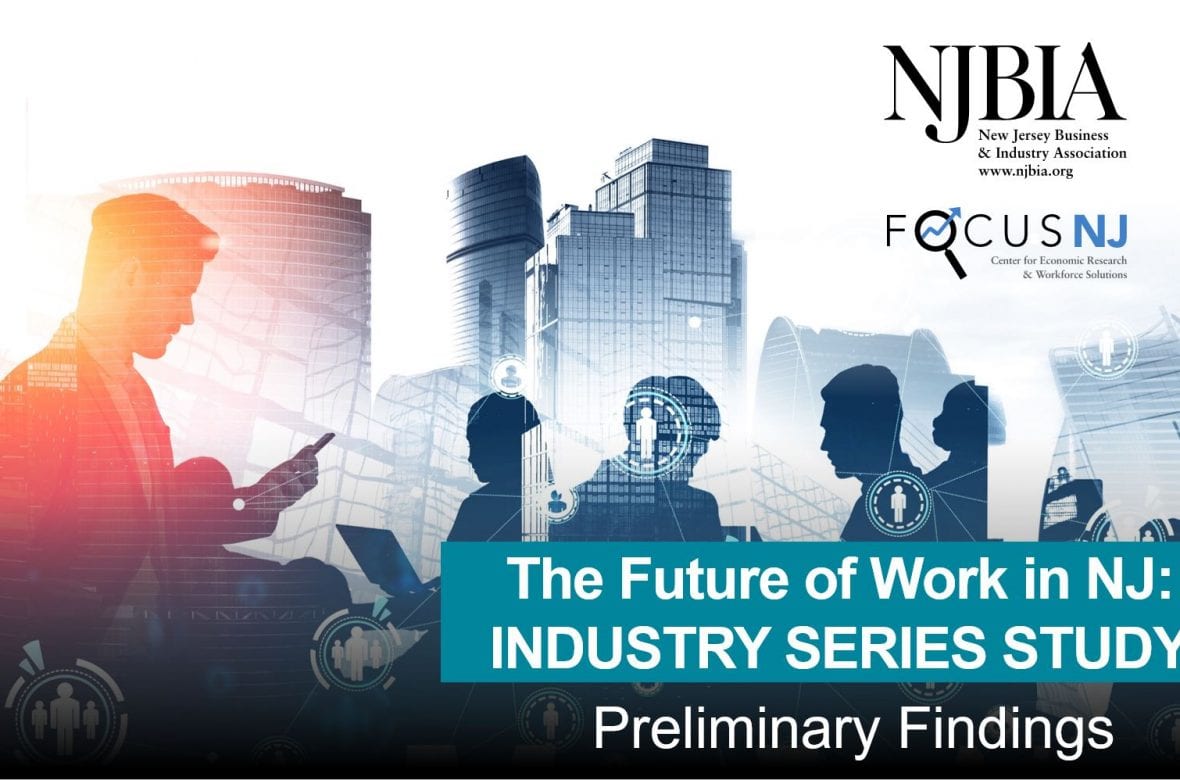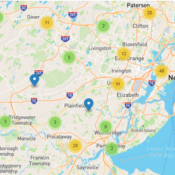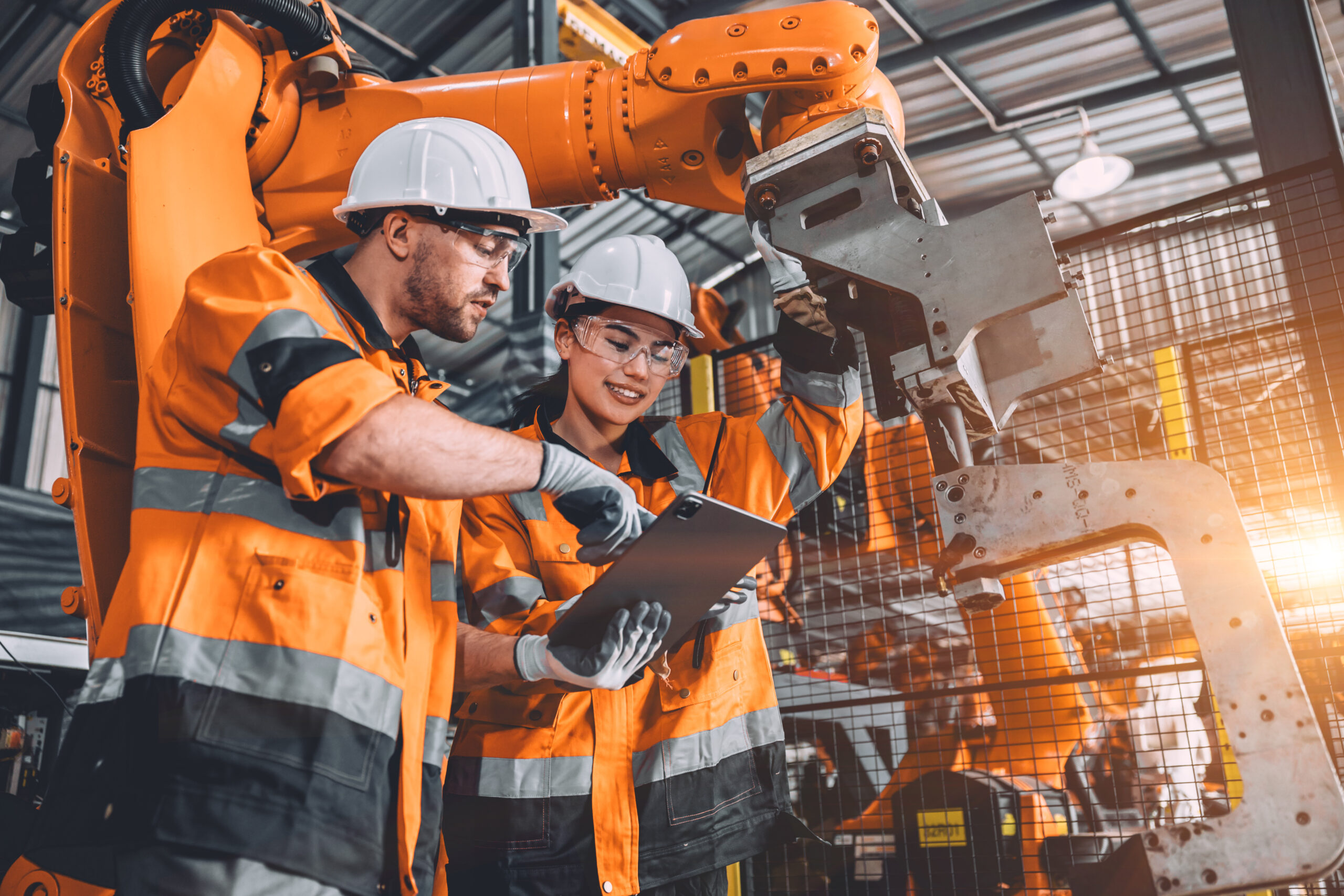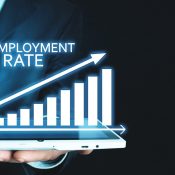The Future of Work in NJ: Preliminary Findings
Understanding the Changing Dynamics within New Jersey Industries
The Future of Work: The Role of Technology & Artificial Intelligence
The jobs of the near future are astonishingly different from the jobs of the recent past. Advancements in technology and artificial intelligence are transforming economies around the world and are requiring businesses to rethink workforce strategy.
According to Accenture Consulting, the rapid adoption of new technologies has prompted companies to prepare for the creation, transformation and elimination of jobs.[1] Given these changing workplace strategies, the World Economic Forum estimates that 54% of the global workforce will require upskilling or reskilling by 2022.[2] These realities reinforce what some already know – the often discussed “future of work” theories are now becoming reality. These dynamic changes are and will continue to have a real impact on workforce needs, posing opportunities and threats for employer and employees.
There is no disputing that technology and artificial intelligence are altering workforces and talent pipelines. However, there is some debate about the impact of these advancements on human employment.
On one hand, these advancements have led to the automation of some jobs and tasks. Conversely, they have also led to the creation of new jobs. Globally, an estimated 75 million human jobs may be replaced by technologies, but 133 million new roles are likely to emerge in a new workforce that includes humans, machines, and algorithms, according to the World Economic Forum.[3] Big data analytics, app/web-enabled markets, machine learning, cloud computing, augmented/virtual reality, encryption, digital trade, wearable electronics, block chain, 3D printing, robotics, autonomous transports, quantum computing, and biotechnology are some of the emerging technologies in the United States that are transforming jobs as we know them.[4] To align with these technologies, companies are reconfiguring required skillsets to fill their new workforce needs.
Technological advancement and artificial intelligence will impact some of the nation’s largest occupational categories. According to McKinsey & Company, office support, food service, production work, customer services, and retail sales are among the careers that are starting to be phased out.[5] At the same time, healthcare, STEM occupations, creatives and art management, and business services are likely to experience occupational growth.[6] In some cases, the new jobs being created may be completely different occupations and/or located in different states all together. McKinsey & Company has predicted that rural U.S. counties may experience a decade of job loss, while urban areas are likely to experience net job growth during the same time span.[7] In addition, “locations with more robust and diverse economies, high-growth industries, and better-educated populations are better positioned for employment growth.”[8]
Regardless of industry, technology and artificial intelligence are a business strategy and workforce reality that are here to stay. With these technological advancements taking place globally and nationally, it is imperative to understand the changing dynamics within the Garden State’s industries so that employers and policymakers can prepare a strong workforce pipeline, ultimately ensuring a strong state economic climate in the future.
The Future Workforce Pipeline: Challenges in the Garden State
There are many programs and partnerships forming around New Jersey that are working to address the changing dynamics of human employment. However, they are currently operating in silos with little inter-connectivity among regional stakeholders to expand these initiatives throughout the state. Often, stakeholders (including businesses, government, academia, and associations) see each other as competitors instead of partners. The opportunity for collaboration is immense and the outcome of sincere statewide partnerships will aid New Jersey in configuring a leading innovation economy with a strong workforce pipeline. As the changing dynamics of the workforce unfold, it is imperative that the business community, academia, and government work together to ensure the skills needed for the jobs of tomorrow are embedded within K-16 education throughout the state today.
Despite recent record low unemployment rates throughout the state[9], the business community is struggling to find talent with the right skills to fill the needs of their advancing companies. According to NJBIA’s 2020 Business Outlook Survey, 6 in 10 businesses have difficulty locating technical/middle skilled (63%) and professional/highly skilled (62%) talent to fill their job openings.[10] Additionally, 81% of New Jersey companies are likely to recruit talent from community colleges, while 75% are likely to recruit from four-year institutions.[11] Meanwhile, 75% of businesses only recruit talent from New Jersey’s postsecondary institutions.[12]
Disappointingly, only 26% percent of New Jersey’s businesses are engaged with their local community college or four-year institution.[13] When asked why they are not engaged, nearly 50% of New Jersey businesses either don’t know who to contact, how to best participate, or they are unaware of available opportunities to engage with postsecondary institutions.[14] This is a major obstacle for New Jersey’s future workforce pipeline.
Given that New Jersey businesses are looking to the state’s postsecondary institutions to fill their workforce needs, it is imperative that postsecondary institutions understand the skills desired by employers to ensure a properly educated workforce pipeline that will provide employees with valuable, employable skills and supply employers with relevant talent.
Connecting the Dots: Bridging the Gap between Business & Academia
Workforce development and excellence in workforce skills are issues that are embedded into NJBIA’s and Focus NJ’s vision for New Jersey. In 2018, NJBIA released a study titled “The Education Equation: Strategies for Retaining and Attracting New Jersey’s Future Workforce.”[15] The study, which was a deliverable from NJBIA’s Postsecondary Education Task Force, was a “Phase 1 deep dive” into researching and analyzing factors that affect New Jersey’s workforce pipeline. The task force, which included 100 prominent members from academia, state education and labor departments, businesses, and young adults, worked to build a framework that sought to better prepare, preserve, and place New Jersey’s future workforce. The group made 13 recommendations to ensure New Jersey’s workforce and the state’s education programs are aligned with the needs of the private sector.
Given the results of NJBIA’s 2020 Business Outlook survey and daily conversations with key stakeholders from the business community, academia, and government, NJBIA and Focus NJ have made it a priority to identify and understand how New Jersey’s industries and the jobs they provide are advancing into the future. As such, the duo has embarked on a “Phase 2 deep dive” into a statewide, seven-industry study to gather insights from New Jersey business and industry to identify the changing dynamics, opportunities, and threats.
The study also seeks to understand how to best prepare New Jersey’s current workforce pipeline for jobs of the future. In addition, the study will determine key industry trends over time, such as employment, wages, and establishment by county. By understanding the changing dynamics of the state’s industries, NJBIA and Focus NJ will continue to work with stakeholders to ensure the quality of New Jersey’s workforce pipeline.
*This research was conducted prior to the COVID-19 health crisis. All research is reflective of a Pre-COVID-19 economy.*
Contributors
Nicole M. Sandelier
Executive Director
Sources:
[1] Lyons, M., Whittall, N., Laurenceau, C. (July 2018). Future Workforce: Getting Worked up with AI: Reimagining the role of humans. Accenture Consulting. Retrieved from https://www.accenture.com/us-en/insights/consulting/reskilling-workforce
[2] World Economic Forum. (September 2018). Insight Report: The Future of Jobs Report 2018. Centre for the New Economy and Society. Retrieved from http://www3.weforum.org/docs/WEF_Future_of_Jobs_2018.pdf
[3] Ibid.
[4] Ibid.
[5] McKinsey & Company. (July 2019) America’s future of work. Retrieved from https://www.mckinsey.com/featured-insights/future-of-work/americas-future-of-work
[6] Ibid.
[7] Ibid.
[8] Ibid.
[9] US Bureau of Labor Statistics. (September 2019) State Employment and Unemployment Summary. Retrieved from https://www.bls.gov/news.release/laus.nr0.htm
[10] NJBIA (December 2019) 2020 Business Outlook Survey. Retrieved from https://www.njbia.org/njbia-2020-business-outlook-survey-shows-less-optimism-for-nj-economy/
[11] Ibid.
[12] Ibid.
[13] Ibid.
[14] Ibid.
[15] NJBIA (Updated 2019) The Education Equation: Strategies for Retaining and Attracting New Jersey’s Future Workforce Pipeline. Retrieved from https://www.njbia.org/2018equation/
Download PDF




